This interview is part of an ongoing series published by the BIMA Immersive Tech Council which aims to draw attention to the groundbreaking work happening in the area of art, technology, and innovation.
Marshmallow Laser Feast (MLF) is one of the world’s leading immersive art collectives, based in London, collaborating with artists, engineers, scientists, and many others. Their work illuminates the hidden natural forces that surround us, inviting participants to navigate with a sensory perception beyond their daily experience. MLF’s work has been exhibited internationally, including at the Saatchi Gallery, ACMI (The Australian Centre for the Moving Image), SXSW, and MLF’s latest production—Sweet Dreams, a surreal, immersive adventure exploring food, consumption, and desire—is on view at Aviva Studios (the home of Factory International), 11 July-1 September 2024.
The following interview took place in June 2024 between Eleanor (Nell) Whitley, Partner and Managing Director at Marshmallow Laser Feast (MLF) and Samantha King, Head of Programme at VIVE Arts (HTC). The interview has been edited and condensed for length and clarity.

Sweet Dreams, photo by James Medcraft, courtesy of Marshmallow Laser Feast.
Let’s start with an introduction to Marshmallow Laser Feast (MLF). Can you tell us about how MLF was formed and how your work has evolved since the studio was founded?
MLF was born out of collaboration. After a few early collaborations Robin (McNicholas), Barney (Steel) and Memo (Akten) (the original co-founders) decided to form as a collective around 2011. In the early years they made some projects that were significant in establishing MLF’s practice. For example, Meet Your Creator, a light show with drones from 2013. This work brought technology on to the stage in a new and unexpected way: not least because it used stage design, moving image, and flying drones together but it was sensory too due to warmth from the lights and wind from the drone fans. MLF went through a metamorphosis and in 2015, Ersin (Han Ersin), Mike (Jones) and I moved from being collaborators to partners in the studio.
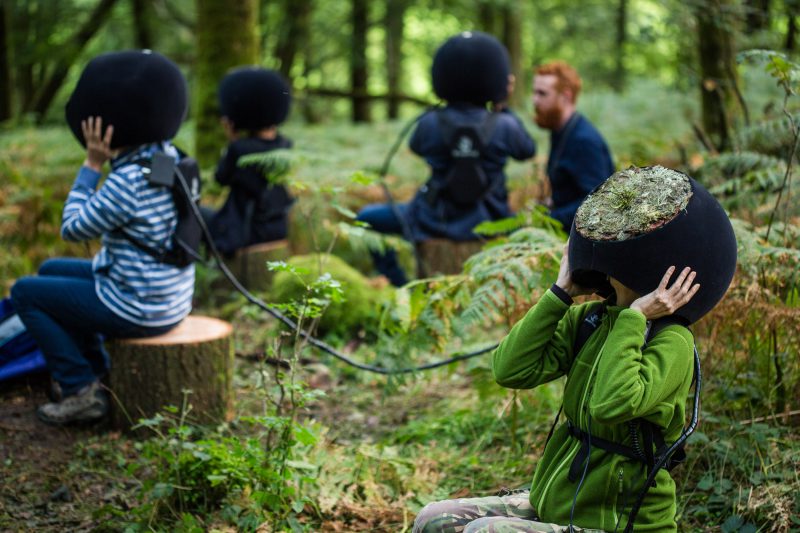
In the Eyes of the Animal, photo by Luca Marziale, courtesy of Marshmallow Laser Feast.
One of our most significant projects was In the Eyes of the Animal (2015), commissioned by Abandon Normal Devices (AND). It was an opportunity to show our intentions for future creative practice. I had been working with MLF for some time and in 2014, together with the team at AND, I wrote a research bid to explore drones, aerial perspectives on landscape, and virtual reality—all of which was somewhat in its infancy then. We won the funding, but by the time it came through the technology had advanced at such a pace it wasn’t so interesting anymore!
We still flew drones over Grizedale Forest, capturing scans and various data. But the magic happened when we took scans from deep within the forest and found a completely different aesthetic. In the Eyes of the Animal was born from that research. It showed what R&D can do in a true sense, how it can take you in a totally unexpected direction. It’s a good example of how we ultimately arrived at the creative concept for the project, using virtual reality to provide audiences with sensory perspectives of different animals.
Looking back, it was chaos. But there was so much trust from the commissioners. It was a real collaboration in that sense. They helped to guide it and to provoke us to think about how audiences were going to encounter the work and interpret it. I’m sure there were moments where they wondered what on earth was happening! But we were confident it would come together and it did. It was a seminal project for MLF as it allowed us to show the world what we were interested in. It opened up a multitude of different ideas for other projects, and demonstrated a new way for how we would tell stories about the natural world.

In the Eyes of the Animal, courtesy of Marshmallow Laser Feast.
Our projects are like stepping stones: In the Eyes of the Animal led to Treehugger which led to We Live in an Ocean of Air. We often create work iteratively, scaling as we go, rather than waiting for a project to be commissioned or funded in its entirety. We’ve often found ourselves needing to show, not tell, to find backers for bigger projects. There has always been a mixture of resources that has allowed us to bring work into the world. Our practice has definitely become more conscious; we’re not just bowling from one opportunity to the next. It’s become more intentional.
I’m really interested to hear you talk about the connections between projects. It seems there are certain themes or strands of inquiry that permeate across MLF’s work. But going back to your point around the mix of resources. Has there always been a blend between commercial projects and creative practice?
There’s no way we could have done what we’ve done without a mix of brief-led work and commissions. This is our version of bootstrapping our passion projects. Or, as any cultural venue might hire out their spaces, we sell our time on other projects to make the studio resilient. An example of a project which has been brief-led and a fantastic opportunity was creating the Heal Institute with (and for) The Museum of the Future (Dubai) which allowed us to really stretch further into experience design for museums. We sometimes get opportunities to do things in a commercial context that we would never get the cultural or research funding to do. These projects often come with a very open brief and we assess them based on what they offer us, not just financially but technically or creatively as well. It’s a reoccuring theme: to look at a project from several perspectives and eke out the exciting angle. It’s a way for us to build resilience and subsidise our passion projects but there are other benefits too, such as the ability to hone our craft or try out a new technology. My role at MLF has evolved from producing to thinking about how as a studio we can position ourselves and maintain resilience in an ever-changing creative industries sector.
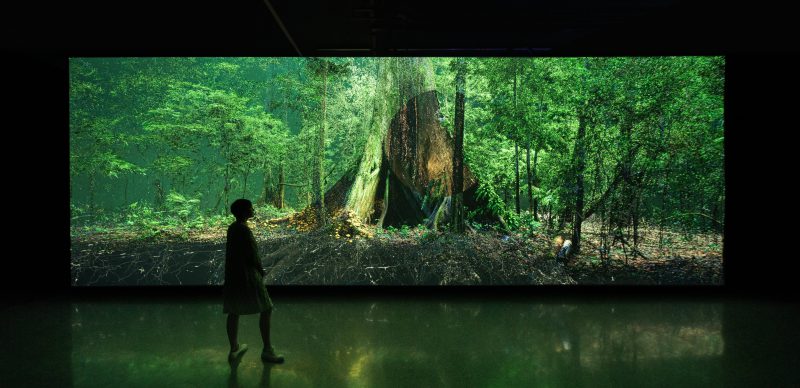
Museum of the Future, The Forest. Image by Sandra Ciampone, courtesy of Marshmallow Laser Feast.
At what point did MLF start integrating research collaborations into its practice?
Collaboration has always been central to MLF’s practice, with scientific research as a subset of those partnerships. We have always asked questions. Who is the best person for the job? What do we want to achieve? What is exciting? Sometimes the research is technological or about experience design. How do we make audiences feel a certain emotion? Or, how can we get the rich media data to seamlessly stream to a headset? Those questions have evolved into research collaborations. For example, for Treehugger we wrote to someone from the Eden Project who also worked at Exeter University to verify what we were doing was scientifically accurate. They were really interested in the work because it visualised what they were trying to communicate to the public too. We received positive affirmations from science communicators and scientific researchers and that helped inspire us with new ideas and encouraged us to create networks with a broad community of people.
Of course, there’s always a different angle for us as artists. Our priority is our audience’s comprehension and perception of the concept, and their connection to it (and often the natural world) as humans. We want to communicate that a tree is a living, breathing thing that exists in a particular way—and isn’t that amazing? We often have discussions about artistic interpretation versus literal science. Most of our partners understand the arts as part of scientific communication.
Do you find these research collaborations and R&D span across multiple projects?
Yes. There is an ongoing deepening of knowledge at MLF, largely stored through human memory and occasionally documented and recorded. We weave that knowledge across our projects, from the research around trees in work like We Live in an Ocean of Air and Treehugger to our explorations around virtual world building from the collaboration with the RSC on Dream, and now virtual puppetry in our latest production, Sweet Dreams.
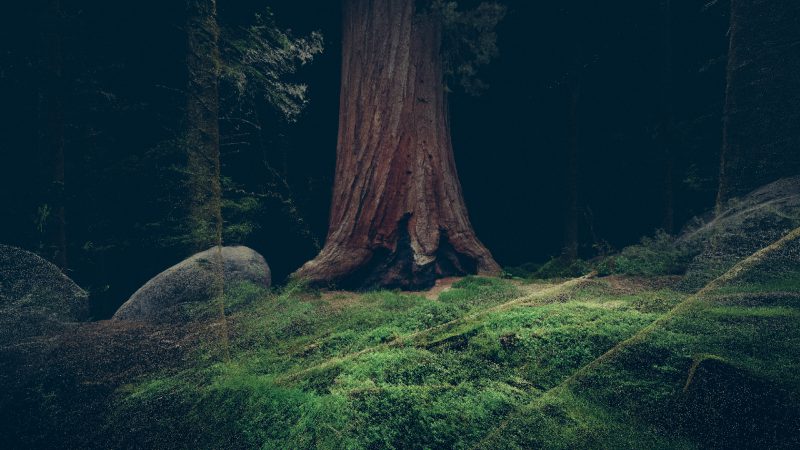
Treehugger, image courtesy of Marshmallow Laser Feast.
This series is about digital experimentation and innovation in arts and culture. A large part of experimentation is not knowing—it’s about risk, learning, and possibly failure. How do you reflect on the value of experimentation in MLF’s practice?
We’re constantly trying to refine our model around how we make work and how we can build in more time to experiment. Play is a hugely important part of our process. We always build in development time at the start of every project, and at the end of each project we have a retrospective process to cement the learnings and make future decisions. It’s research but it’s always applied research. We never have the capacity to do open-ended R&D. When we are commissioned to do R&D there is always an expectation that there will be an outcome or to exploit the results.
We often debate the fact that if we had more time to play and experiment, the results of the work would be better. But our business model is to sell our time so you either become very expensive or it’s just not possible. You have to balance how important play is with how long you actually need to make the work.
MLF is on a constantly moving train. We’ve been making, making, making for the past ten years. Sometimes I think it would be lovely to have the freedom to digest and reflect on what we’ve done and share those learnings more widely. We went some way in doing that with Dream through the online resource Findings in the Future of Live. Because we made Dream in the middle of a pandemic—and it was a mad time for everyone during the making of that production—the people involved held all of the knowledge and know-how we had developed in little bubbles. So we decided the most effective way to share our learnings would be to get the team together in virtual rooms to talk about what they have been through and document that for others. Of course it all dates so quickly! But we hope it has / had value.

Dream by Marshmallow Laser Feast in collaboration with The Royal Shakespeare Company, Manchester International Festival and Philharmonia Orchestra, image courtesy of Marshmallow Laser Feast.
After so much experience with R&D, often in collaboration with a diverse range of partners, does that process happen within a particular framework for MLF? Does MLF have a methodology you have found to be rewarding when it comes to R&D or does it change every time?
We have a process but it adapts each time depending on the context of the project and the risk appetite of everyone involved. We’re very deliberate about having open modes and closed modes. At the start of a collaboration, we are open. We listen to everything and everyone. Then the development process has to close, we have smaller and smaller groups of people making decisions. That’s a very important operating mode for us. It’s also important for running a studio as there is always a cost to collaboration. Saying that, we always take the perspective that collaboration helps to find a new angle, a new direction. It makes a better project because it’s open to more people and therefore a diversity of thought. There are always risks and challenges, but every collaboration we’ve ever done has lifted us to a better plane than if we’d just shut the door and done it by ourselves.
The biggest weakness and strength of MLF is that we’re often reinventing the wheel, either through our methods or conceptually. We’re trying to find a different way to talk about something. My role is to find the right conditions to make that magic happen. One rule is: don’t do too many new things at once, because otherwise it all collapses.
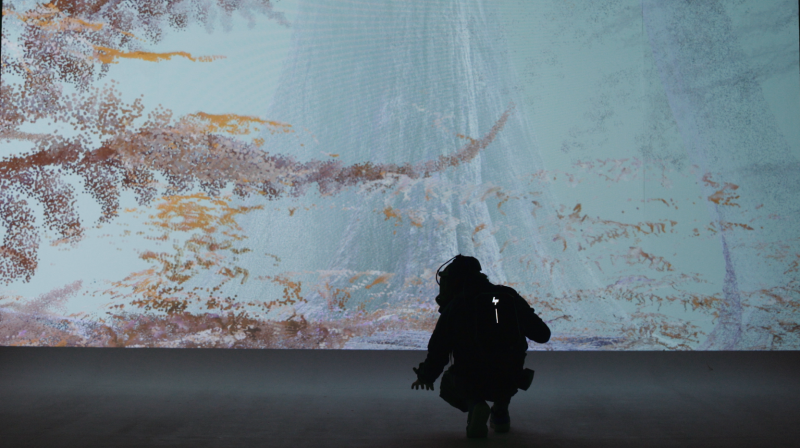
We Live in an Ocean of Air, image courtesy of Marshmallow Laser Feast.
Is there always a consensus within MLF together about the direction you should be going in?
Someone once said to me: there’s a difference between consent and consensus. We might not get consensus but we’ll always have consent. That’s very important in a collective as you can’t design everything by committee. Mediocrity kills, right? I might not agree with the approach, but I’m willing. For example, when we did We Live in an Ocean of Air, we said: “We’re going to do this. We’ll be paying it off for years. But should we just do it and see where it takes us.” We all consented to that process. There’s a nuance, but it’s an important one because it allows that creative individual to have an identity within a collective.
We’re a small independent studio. We can’t do everything we’d perhaps like in terms of sector support, but we want to play our part. Robin will often say that as an independent studio we are married to the idea that independent ideas and creatives can be resilient and sustainable, and that’s very important for society. Much of our R&D work is aimed at supporting that. We have to maintain the confidence to navigate on our own terms and do what we can for the sector. But at the end of the day, we’re still a studio trying to make work.
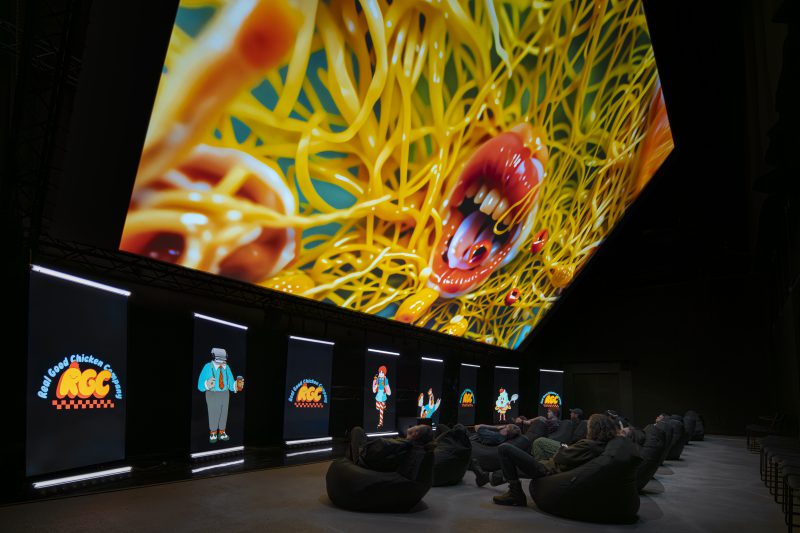
Sweet Dreams, photo by James Medcraft, courtesy of Marshmallow Laser Feast.
Can you talk about how your latest production Sweet Dreams at Factory International came into being? I believe it started as a VR project? How did you evolve the experience from early iterations into the production audiences will see at Factory International?
Sweet Dreams is a multi-room immersive, interactive experience about a fast-food mascot called Chicky Ricky who works for the Real Good Chicken Company. Chicky Ricky is faced with a dilemma: rebrand or die. He’s no longer fit for purpose. Consumer tastes have changed and the stock price of the company is falling. So he goes on a journey to find out what people want and therefore who he should be as the face of that brand. It’s about food and desire. It’s about what we want.
It started life as a virtual-reality prototype which explored sensory interactions through a series of vignettes. We took it to various events in 2019 including Sundance New Frontiers, an event in New York for the Great Britain campaign, and in London, supported by the BFI (who have long supported the development of this project through the BFI Filmmaking Fund). The BFI helped us to understand that the project had lots of potential but there wasn’t a clear narrative . So we rewrote it with Simon (Wroe) as an embodied world in which audiences met and became various characters, and through which we explored themes of food, culture, wealth, greed, and desire.
For me, it broke the “too many new things” rule I mentioned previously. We wanted to make a feature-length production, with a new IP, using new storytelling themes, and in a new format. It was a huge commercial risk. Factory International challenged us to rethink how we might tell a similar story out of headset. The BFI have also been amazing in supporting us to achieve the story we wanted for the project. That process of rewriting and redesigning helped us to look at our craft and understand how we tell stories in new ways, not using one particular technology. For the production at Factory International, we’re exploring a new form of promenade cinema presented in a physical space, but we will also release a streaming version in the future as well.
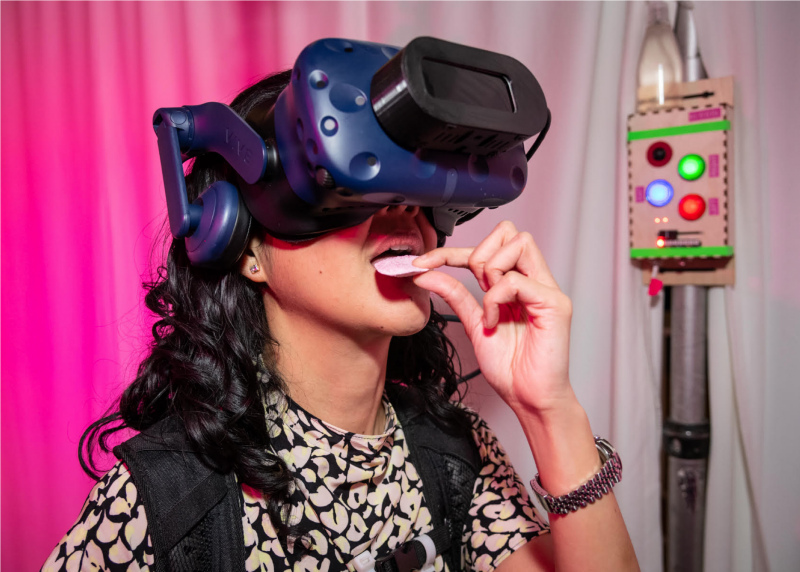
Sweet Dreams – VR prototype presented at Sundance, courtesy of Marshmallow Laser Feast.
Process is incredibly important in MLF’s work—both as a subject of artistic inquiry (the process of the body or perception, the process of photosynthesis, the process of mycelial connection)—but also in your approach to making work in an iterative way. How do you think about the process of experimenting and making versus the final outcome of a project? Is there ever a final outcome, or does the work just continue to evolve across different iterations?
That depends who you ask at MLF! You said it, we’re very iterative. But who is that iteration for? I often say, is it for us, as the artist? Is it for the audience? With Sweet Dreams, we’re presenting the work as an immersive, live experience but we’ve also learnt through projects like Dream that we can reach a phenomenally large audience by putting our work online. It’s an audience growth strategy. A good iteration allows us to take the same project and push it to new audiences in different ways. Individual projects are both complete but also part of an evolving body of work. We’ll revisit a work for a new canvas or a new technology. For example, In the Eyes of the Animal was originally a VR work which we then iterated to a 180 degree screen as well as a 360-dome work. It showcases the “capture once, deliver to many” technique. It’s an important way for us to work.
What is your clarion call to the sector regarding artistic R&D? What’s needed to create a healthy R&D ecosystem for arts and culture?
For me, there are two key issues. Firstly, the skills agenda. There’s a big difference between innovation and supporting digital skills and training. In order to push things forward, we need to support creatives who are working at the vanguard and who will create a feedback loop back into industry. Otherwise it’s just people learning what’s already out in the world: that’s not innovation.
The skills agenda also needs to be less siloed. How can we build cross-sector knowledge between the specialist craft and the generic practice? What is the knowledge that will help the ecosystem in a macro sense and where are the places for specialism? For example, on a VR course they are probably teaching the same skills that are needed across many different industries, e.g. filmmaking, games, web3, virtual infrastructure. There’s been an issue with skills in film for years because it’s hard to bring in talent fast enough. Where we now see screen technologies converging, we should be acknowledging that challenge within the skills agenda.
The second strand is funding advanced creative practice which I see as critical to the ecosystem. MLF is a studio of around 20 people. So, of course, I’m interested in funding being made available to organisations like us, not because I’m selfish and I just want to get all the commissions for my studio, but because of job creation. When we have access to production funding, development funding, creative R&D funding etc, it allows us to create jobs. So my call is for proportional and sustained funding for mid-career and advanced practitioners to allow for scale, impact, and job creation in the independent sector. With scale we have more assets to distribute with a higher value proposition to our audiences. The sector should be making more features, less shorts. Audiences of the Future did some really interesting things by funding demonstrator projects at different levels. It allowed some great work to be brought into the world and many of the projects have led to further commissions, jobs, and cultural assets in the country—Sweet Dreams being one of them. We see a lot of R&D money going to universities in the UK. But if you want to build skills in R&D for the creative industries, it seems logical to fund organisations who are already practising fast-paced innovation in their work. Industry can support the skills agenda and achieve scale.
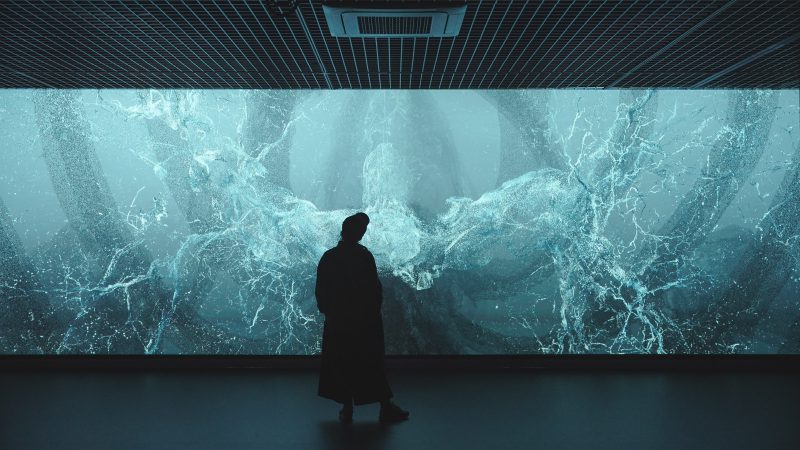
Evolver, image courtesy of Marshmallow Laser Feast.
What are some of the live interesting questions on MLF’s radar—creative or technical—that you are yet to answer?
We’re excited to be actively partnering with our collaborators Nilor to explore latent space technology and generative AI tools—at both an industrial and creative level. In all of our investigations, we want to keep pace but also maintain a sound, ethical logic which can elevate and benefit our peers and our sector.
And finally, what’s coming up next for MLF?
We’re announcing a new museum gallery soon which we’re really excited about. We hope to bring our ACMI show Works of Nature over this side of the world soon, and hopefully show Evolver in the UK in the near future. Watch this space!
Links:
Marshmallow Laser Feast (website)
Dream, Dream and Findings from the Future
Sweet Dreams at Factory International